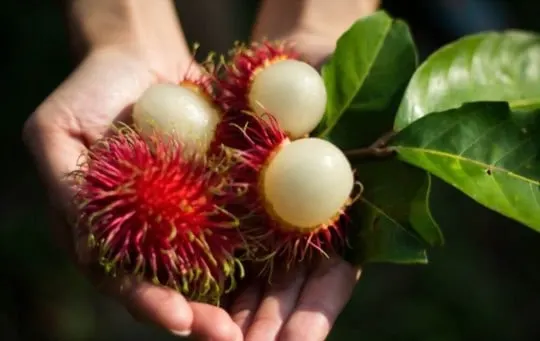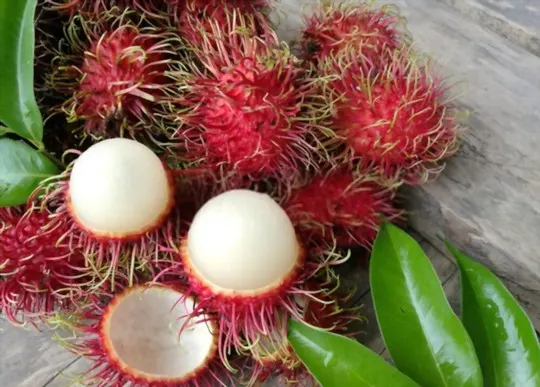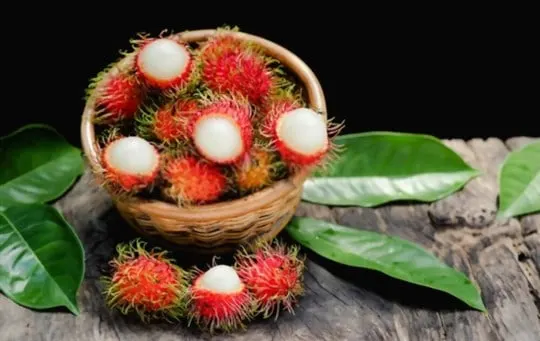When strolling down an Asian market, have you ever come across a spiky, red fruit and wondered, what on earth is that?
Well, that’s most probably a fruit named rambutan.
Though it might look intimidating initially, this fruit is quite delicious and tastes similar to grapes.
But that’s what some people say; others claim it tastes more like a cross between a lychee and a grape.
Guess you’ll have to try it yourself to find out what does rambutan taste like exactly.
However, if you want a solid understanding of what to expect from this unusual fruit, read on.
What is Rambutan?

Rambutan, also called Rambotan, is a tropical fruit native to Malaysia.
The name rambutan is derived from the Malay word for ‘hairy,’ which is rambut.
It’s in reference to the hairy, spiky exterior of the fruit.
Rambutan fruits grow on evergreen trees that can get as tall as 15-25 meters.
The trees produce small, white flowers that turn into the Rambutan fruits.
They’re closely related to several other tropical fruits such as pulasan, longan, guinep, and lychee.
In fact, rambutan is a lot like lychee in terms of appearance (minus the spikes), taste, and how it’s eaten.
As for the variety, there are two main categories- red and yellow rambutans.
Some of the most popular and best-tasting varieties of the fruit include Queen Zaida, Victoria, Laurel, Zamora, and Ponderosa Ferreras, to name a few.
What Does Rambutan Taste Like?

Along with its elegant coloration, the rambutan is widely attributed for its taste.
So, without much delay, let’s dive into what it exactly tastes like.
The taste profile of the rambutan is a combination of sweet & sour, backed by floral undertones.
Upon closer taste, it resembles a grapey flavor but with a unique tone of its own.
The first bite of this spiky fruit is somewhat as intimidating as its look.
However, once the outer shell is broken, a creamy and soft gelatinous texture waves off the initial resistance.
And yes, it’s juicy as well. A rambutans inner filling is pretty creamy and delicious.
But, its inner seed? Not so much. So, be wary of it.
The long seed is found at the center and carries a bitter flavor, which many undoubtedly find unpleasant.
Some consume the pit, but its toxic property can injure your health.
Although noted for its sweet and sour mixture, a rambutans flavor will often vary based on its freshness.
This means a canned rambutan cannot compare to a fresh one – well, at least in terms of taste.
Nutritional content-wise, rambutans contain rich antioxidants, which act as a great immunity booster against several diseases.
It is also a great carrier of vitamins E, C and A, thus, aiding in maintaining eye health and preventing macular decay.
Rambutans are a highly nutritious fruit supported by shallow fat properties.
This makes the fruit an exceptional food item for a weight loss diet.
And the great thing is, it won’t keep you hungry the entire day.
How to Cook and Use Rambutan?

If you’ve never tasted or cooked with rambutan before, don’t worry.
It’s actually quite simple, and you don’t have to be a kitchen pro.
The crucial part is to select the right fruit.
You want the ones that are firm to the touch and have a vibrant color.
Avoid ones that are mushy or have brown spots on them.
Once you’ve selected your fruit, it’s time for preparation.
The first step is to remove the spikes on the exterior.
You can do this by using a sharp knife or scissors.
Note that both the peel and seed of the fruit are considered inedible.
So, make sure to remove them. At this point, your fruit is ready to be eaten.
You can eat it as is or use it in cooking.
For example, you can add rambutan to fruit salads and smoothies or even use it as a decoration on cakes and other desserts.
One of our favorite ways to enjoy this tropical fruit is in a drink.
We like to add rum, vodka, or even tequila to a blender with some rambutans and ice.
The result is a delicious and refreshing cocktail perfect for hot summer days.
If you want to get a little more creative, you could also use rambutan to make jams, chutneys, and sauces.
Conclusion
If you’re a fruit enthusiast engrossed in trying a new fruit, a rambutan should definitely be on your “to buy” list.
It’s tasty, juicy, and healthy.
What more can one ask for? Once you get a taste of a rambutan, you’ll soon realize it’s as exceptional as its unique look.
And the fruit is now abundantly found in various farmer’s markets or grocery stores throughout summer.
For those looking at a meal plan, a rambutan can serve as a substantial breakfast component.
But, if you’re looking for something heavier, you can try some of the recipes we mentioned earlier.

What Does Rambutan Taste Like? Does Rambutan Taste Good?
Ingredients
- Rambutan
- Ingredients from your favorite recipes
Instructions
- Depending on the ingredients used, the cooking method, and the type of dish, the taste of the food can vary greatly.
- Make sure to select a recipe that will elevate the food’s original flavor, and enjoy experimenting with different recipes!

Andrew Gray is a seasoned food writer and blogger with a wealth of experience in the restaurant and catering industries. With a passion for all things delicious, Andrew has honed his culinary expertise through his work as a personal chef and caterer.
His love for food led him to venture into food writing, where he has contributed to various online publications, sharing his knowledge and insights on the culinary world. As the proud owner of AmericasRestaurant.com, Andrew covers a wide range of topics, including recipes, restaurant reviews, product recommendations, and culinary tips.
Through his website, he aims to inspire and educate fellow food enthusiasts, offering a comprehensive resource for all things food-related.

Leave a comment